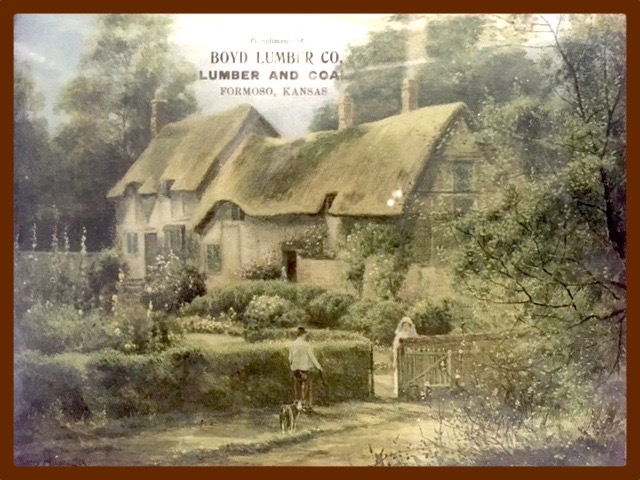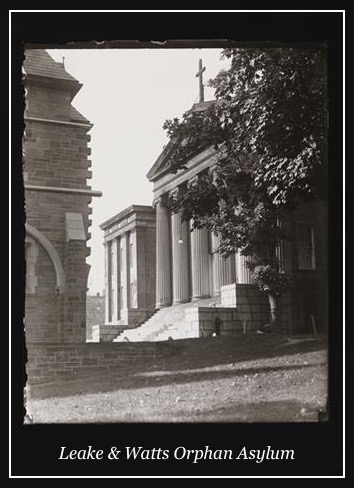My cousin Jim Dieckman stirred up my OCD tendencies lately when he emailed me a photo of one of his late mother’s treasures, a souvenir of Boyd Lumber in Formoso. It’s a framed reproduction of a bucolic scene featuring an English wattle and daub house with a thatched roof and a verdant garden. A woman inside the gate exchanges pleasantries with a man out for a walk with his little dog.

The house is not just any house, but one that was the model for countless paintings and engravings of the late Victorian era, the home once owned by Anne Hathaway before she became Mrs. William Shakespeare. The historic residence was photographed at that particularly attractive angle in 1880, and has been used as a model for commercial artists ever since.
I imagine the framed picture may have been given away by lumberyards because it represented a sentimental fantasy of small-town life and home ownership, a notion of what your old place could look like if you added enough additions to it, all made from materials provided by your local dealer. Perhaps, with the right care, your humble abode could weather the centuries, just as Anne’s obviously had. Since Boyd Lumber Co. also sold coal, the three smoking chimneys below the sponsor’s imprint were also a reminder of where to go when the fuel ran out.
Jim later sent a view of the reverse side of the picture, revealing a name on the back suggesting that the early 20th-century tchotchke had once been owned by Opal Watson. I was reminded of all those Watsons I had known or heard of in the Formoso area, and decided it was finally time to take a closer look at a White Rock pioneer named Robert Watson, and delve into his family history. Though most of what I found was covered in my previous post - there’s another intersting angle to his story.
Learning from census data that Robert had been born in New York of parents who emigrated from England, I quickly zeroed in on a carpenter named William Watson who in 1850 lived with his Irish wife Ann and their four children in Oswego, along the southern shore of Lake Ontario. The eldest child in the Watson household was an 11-year-old named Robert. However, keeping in mind that Robert Watson of White Rock fame was a divorced man who in his later years lived as a hermit and was reported to have had no family when he died, I also kept circling back to an 1850 census of the Leake and Watts Orphan Asylum in New York City.

The Robert Watson buried in White Rock Cemetery was a G.A.R. veteran who was said to have served in the Army for eleven years, and there was a native of New York City named Robert Watson who signed on for a five-year stint in August 1855. In April 1861, eight months after his term of service expired, he answered his country’s call for volunteers, giving his occupation as “soldier.” After three more years in the infantry, Private Watson re-enlisted in 1864 and joined an artillery unit. It’s easy for us to believe that a young man growing up in an institution might be drawn to a career in the military, a surrogate family that demands order and discipline, but confers a sense of community and security. Unfortunately, my effort to match up Robert Watson the orphan with Robert Watson the soldier, ran into a few minor obstacles.
In the 1850 census of the Leake and Watts Asylum, Robert Watson is listed as a 12-year-old inmate. That boy should have been only 17 in 1855, when a hungry New Yorker with the same name described himself to a recruiter as a 21-year-old farmer. However, later in life when he answered census questions at White Rock, Robert Watson’s reported age could vary even more widely - though usually by only four years. Ignoring the date carved on his headstone (1840) and the most bizarre guess featured in his listing on Ancestry.com (1795), most documents yield an estimated birth year for Robert of either 1834 or 1838. It may be more than coincidence that the earlier date squares with the reported age of a career soldier, the later one, with the age of an orphan at the Leake and Watts Asylum.
It may be either that, having grown up without a family Robert Watson wasn’t quite sure about his age, or that he never gave the matter much thought. If the young veteran had come West from New York City, Watson may have been a member of the starry-eyed Excelsior Colony, most of whose members hailed from Brooklyn. The group, composed mostly of mechanics and carpenters, had been sold an idyllic dream about owning a little farm on the prairie, one which was quickly dispelled by a vengeful band of Cheyenne Dog Warriors.
While many of the would-be farmers scattered following the Indian attacks of 1869, Watson stayed on, living alone in a shack in the broad belt of woods lining White Rock Creek, only staggering to a neighbor’s house on his last day to spend his final hours being cared for by neighbors. Whether he was an orphan or not, we know enough about him now to be fairly certain that when the ex-soldier and pioneer perished of a fever in 1886, Robert Watson was only 48.